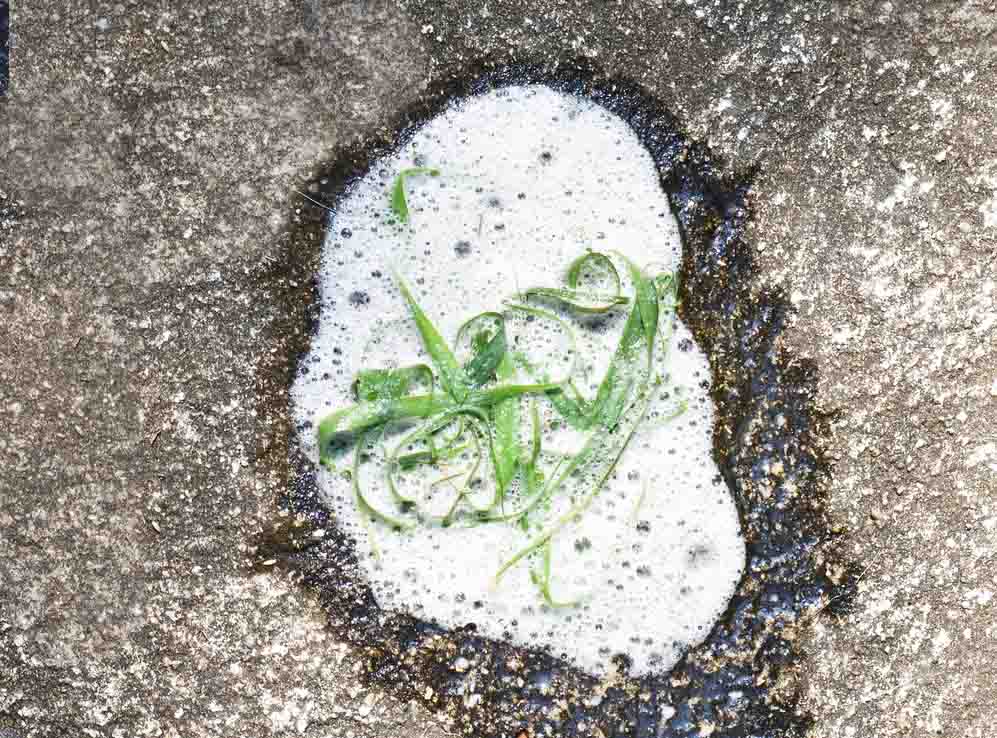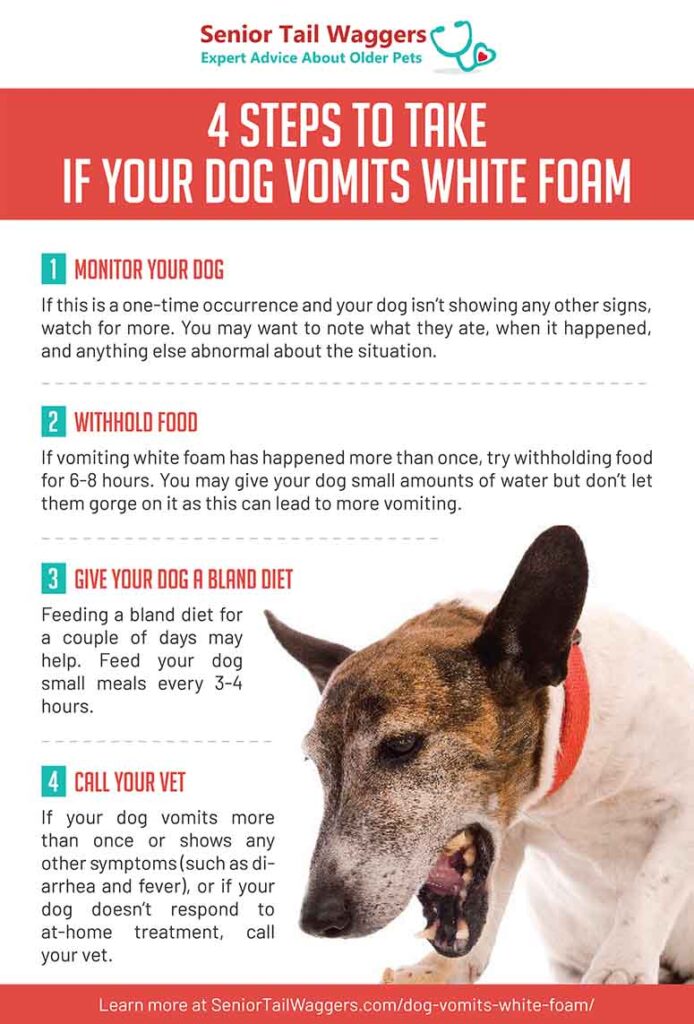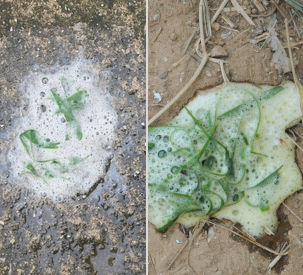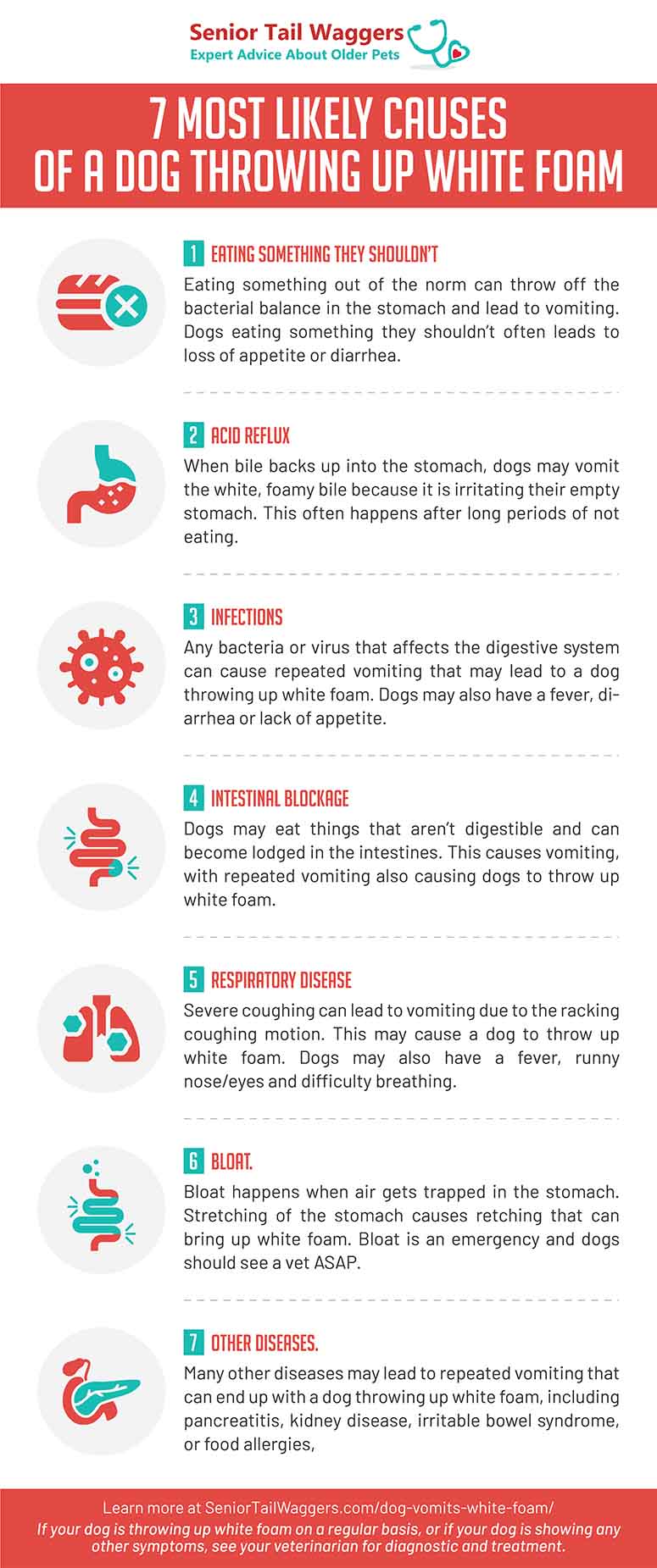
This article was updated on December 3rd, 2023

Any time your dog vomits, it may cause your stomach to turn a little with worry and concern. When your dog is throwing up white foam, it may make you confused and even more uneasy.
After all, most dog vomit looks like the food he just ate, not a frothy mess. So, what are the causes of a dog throwing up white foam and what can you do about it? If your dog has vomited once, or multiple times, when it is cause for concern?
Steps to Take If Your Dog Vomits White Foam [Veterinarian Advice]

Here are some steps you can take to ensure that your dog is taken care of properly:
1. Monitor your dog
If this is a one-time occurrence and your dog isn’t showing any other signs, watch for more. You may want to note what they ate, when it happened, and anything else abnormal about the situation.
2. Withhold food for 6-8 hours
If vomiting white foam has happened more than once, try withholding food for 6-8 hours to see if it helps clear up the indigestion. You may give your dog small amounts of water, but don’t let them gorge on it, as this can lead to more vomiting. Take note of any abnormalities as before. If your pup starts to show any other signs, such as diarrhea, abdominal pain, dehydration, or you can’t get the vomiting to stop, contact your veterinarian.
3. Give your dog a bland diet
Sometimes, cases of indigestion respond to feeding a bland diet for a couple of days. You can feed your dog small meals of this every 3-4 hours to help settle stomach acid. Contact your veterinarian if your dog shows any other signs or if vomiting white foam doesn’t get better within 48 hours. Read our post: 11 Proven Bland Diets for Dogs with an Upset Stomach.
Call your vet after 48 hours (or earlier if your dog shows other signs of illness)
For repeated vomiting of white foam that doesn’t respond to your at-home treatments after 48 hours or if your pup has diarrhea, a fever, abdominal pain or is becoming dehydrated, call your vet before 48 hours.
Severe abdominal pain, unstoppable retching, high fevers, or dehydration all warrant an immediate visit to your veterinarian and shouldn’t be treated at home.
Below are our infographics summarizing steps to take if your dog vomits white foam:

It’s also important to understand why your dog threw up. Let’s now review the most likely causes:
What if My Dog Vomited Multiple Times?
Most single-instance cases of a dog throwing up white foam will resolve on their own or with the home treatments recommended above. However, multiple episodes may require professional diagnostics and treatment. Don’t hesitate to call your veterinarian if your dog has vomited multiple times. This may be over the course of a couple of hours or even a couple of days.
Along with that, call your veterinarian if your dog isn’t wanting to eat for more than 24 hours, has diarrhea for longer than 2 days (48 hours) or if your dog is showing other signs of illness.
What It Looks Like
A dog throwing up white foam looks just as you would imagine. Rather than vomiting up food, a white, frothy liquid comes out. The foamy part is due to air moving in and out of a dog’s mouth while they’re in the process of vomiting. This adds bubbles to the liquid that is on its way back out.

Because of this, white foam can occur any time a dog vomits. Sometimes it may be mixed in with the food in the vomit and sometimes, it is by itself. Any time a dog vomits white foam alone, it means that their stomach is empty and white foam is all there is to come up (see picture below).
So, if a dog’s stomach is empty, where does the white liquid come from? If a dog’s stomach is empty, either because they aren’t eating or because they have thrown up recently, they may vomit bile, or stomach acid. Again, when the bile comes up from the stomach, it gets all foamy and frothy by the air moving in and out with the retching motion.
For this reason, a dog throwing up white foam may be due to any of the same things that cause any other type of vomiting. It could also be because they ate something white very recently and are actually regurgitating it back up.
So Why Is This Happening? 7 Most Likely Causes
Since vomiting white foam can be brought about by the same causes as vomiting food, part of this list might sound familiar. Vomiting white foam is most often a result of a digestive issue that causes repeated vomiting, and the foam comes up once the stomach is empty:
1. Eating something they shouldn’t
Any time a dog eats something out of the norm, it can throw off the bacterial balance in the gastrointestinal tract and lead to vomiting. This is especially true if they eat foods that are high in fat, such as table scraps or garbage. When a dog vomits repeatedly, you may see some white foam.
Other symptoms: Dogs might not want to eat and may have diarrhea with this as well. As long as signs aren’t severe, you can monitor them for 24-48 hours, withhold food, and offer small amounts of water.
Vet treatment: If signs persist for longer than 48 hours, or if they’re showing a lot of discomfort or becoming dehydrated, see your veterinarian. They may need to give anti-nausea medications, fluids, and a special diet.
2. Acid reflux
When bile from the intestines backs up into the stomach, dogs may vomit the white, foamy bile because it is irritating their empty stomach. This most often happens after long periods of not eating, such as in the morning or right before dinner. You can try feeding your dog smaller meals more frequently to help neutralize the excess stomach acid. Antacids may help decrease the amount of irritation and may be prescribed by your veterinarian.
Vet treatment: If you can’t control your dog’s acid reflux with at-home treatments, your veterinarian may prescribe more potent acid-reducing medications or try to figure out the cause of the acid reflux.
3. Infections
Any bacteria or virus that affects the digestive system can cause repeated vomiting that may lead to a dog throwing up white foam. Infections are best treated by a veterinarian, but you may try to withhold food, offer small amounts of water, and monitor them for 24 hours unless signs are severe or they become dehydrated.
Other symptoms: Dogs may also have a fever, diarrhea, not want to eat, or have stomach pain.
Vet treatment: Veterinarians will treat infections with fluids, anti-nausea medications, antibiotics, and other supportive care.
4. Intestinal blockage
Dogs may eat things that aren’t digestible and can become lodged in the intestines. This causes a backup of digested food that will eventually reach the stomach, causing vomiting. Repeated vomiting may lead to throwing up white foam.
Other symptoms: Intestinal blockages may cause a decrease in appetite, stomach pain, and lack of feces.
See your veterinarian if your dog is showing any of these signs.
5. Respiratory disease
Severe coughing can lead to vomiting just due to the racking coughing motion. This may cause a dog to throw up white foam to clear their airways, or it may come from the stomach. You can try to loosen chest congestion with steam from your shower, but most dogs are going to need veterinary care.
Other symptoms: Dogs may also have a fever, runny nose and eyes, or difficulty breathing.
Vet treatment: Respiratory diseases may need antibiotics, cough medications, and anti-inflammatories. Occasionally, medications to dilate the airways may be needed as well.
6. Bloat
Bloat happens when air gets trapped in the stomach. The stretching of the stomach causes retching that can bring up white foam.
Other symptoms:
- distended and painful stomach,
- restlessness and
- panting.
Vet treatment: Bloat is an emergency, and dogs should see a vet immediately.
7. Other diseases
Many other diseases may lead to repeated vomiting that can end up with a dog throwing up white foam. Pancreatitis, kidney disease, irritable bowel syndrome, food allergies, and some types of cancer may all be to blame. If your dog is throwing up white foam on a regular basis, see your veterinarian for diagnostics and treatments of these diseases.
Infographic summary: top causes

What Are the Dangers of a Dog Throwing Up White Foam?
The occasional upchuck typically isn’t anything to worry about. It may just mean your dog has a little irritation in their stomach or throat that needs to be cleared. However, if throwing up becomes a regular thing, it may be an indication of a serious underlying condition that needs to be looked at.
White foam may also be highly comprised of bile acid, which may be damaging to some surfaces, especially wood. If your dog is throwing up white foam, be sure to clean up messes quickly to prevent damage to your wood floors or furniture.
It’s not uncommon for dogs to eat their vomit, white foam is no different. However, eating the acidic white foam may cause further digestive upset or indigestion, so it’s best to keep your dog and others from eating it.
When Should My Dog See a Vet
Call your veterinarian if your dog has vomited white foam multiple times (over the course of a couple of hours or even a couple of days). Along with that, call your veterinarian if your dog is showing other signs of illness (For example, if your dog does not eat for more than 24 hours or has diarrhea for longer than 2 days).
Fevers, abdominal pain, or dehydration where the gums feel sticky or dry all warrant a veterinary visit. So does listlessness or lethargy that lasts longer than 48 hours.
Dogs that have severe abdominal pain, restlessness, panting, or a distended stomach should seek veterinary care immediately. Also, dogs that ingested a toxic substance should consider an emergency visit.
Veterinarians will try to determine the cause of your dog vomiting white foam. They will perform an examination, possibly blood work, x-rays, or ultrasound, or take a sample of the white foam or feces.
The treatment will then depend on the cause and consist of fluids, anti-nausea medications, antacids, antibiotics, surgery, or hospitalization. The cost can vary from $200 for a simple infection to $2,000 or more for emergency bloat or intestinal blockage surgery.
Prevention
If your dog has had issues with throwing up white foam in the past, be sure that those underlying conditions are properly treated and under control. Chronic illnesses, such as kidney disease and irritable bowel syndrome, will require life-long management that may lead to a relapse of vomiting white foam if they’re not properly handled. This may mean a change in diet or regular medications.
Make sure your pup is up-to-date on vaccinations to help prevent diseases like parvo and kennel cough that can cause him to vomit white foam.
If your dog has known food allergies, avoid those ingredients that cause vomiting and other digestive upset. Also, if your dog likes to eat things other than their regular food, make sure to keep their environment clean. Lock up your garbage, don’t feed table scraps, and don’t allow small toys, rocks or anything that can be swallowed whole where he can get them. Consider crate training your dog so that they have a safe place to be while you’re away to prevent indiscriminate eating and ingestion.
Always monitor your dog for other signs if they vomit white foam. Note what they ate, when they ate it, and any other abnormalities so that you may notice a pattern to help diagnose the problem and prevent it in the future.
FAQ
Grass is thought to be an irritant that dogs swallow in order to induce vomiting because they have an upset stomach. When dogs are feeling a little upset, they may eat grass to try to relieve it.
Related Posts about Dogs Vomiting Issues
 Dog Vomiting Blood: Our Veterinarians Explain What to Do - Seeing your dog vomit is upsetting enough, but vomiting blood can be downright scary. So what are the possible reasons… [...]
Dog Vomiting Blood: Our Veterinarians Explain What to Do - Seeing your dog vomit is upsetting enough, but vomiting blood can be downright scary. So what are the possible reasons… [...] Dog Vomiting Blood but Acting Normal: Top Reasons and Solutions - A dog who vomits blood is enough to set off alarm bells in your head. Sure, dogs vomit all the… [...]
Dog Vomiting Blood but Acting Normal: Top Reasons and Solutions - A dog who vomits blood is enough to set off alarm bells in your head. Sure, dogs vomit all the… [...] My Dog is Vomiting but Acting Normal: What Could it be? - Dogs vomit for all sorts of reasons. As their loving owners, we naturally become concerned and want to find out… [...]
My Dog is Vomiting but Acting Normal: What Could it be? - Dogs vomit for all sorts of reasons. As their loving owners, we naturally become concerned and want to find out… [...] Why Dogs Throw Up Undigested Food [with 7 Tips from a Vet] - Doggy vomit. It’s an affliction any dog parent is only too aware of. However, did you know that when it… [...]
Why Dogs Throw Up Undigested Food [with 7 Tips from a Vet] - Doggy vomit. It’s an affliction any dog parent is only too aware of. However, did you know that when it… [...] Dog Who Vomits and Has Diarrhea? Our Vet Shares 4 Tips - In our veterinarian clinic, it is typical for me to see at least 2 to 3 owners each day whose… [...]
Dog Who Vomits and Has Diarrhea? Our Vet Shares 4 Tips - In our veterinarian clinic, it is typical for me to see at least 2 to 3 owners each day whose… [...] What Should I Do if My Old Dog Vomits [3 Tips from a Vet] - Vomiting is a symptom that always causes concern amongst owners, and for good reason. While vomiting can be a sign… [...]
What Should I Do if My Old Dog Vomits [3 Tips from a Vet] - Vomiting is a symptom that always causes concern amongst owners, and for good reason. While vomiting can be a sign… [...]Disclaimer: This website's content is not a substitute for veterinary care. Always consult with your veterinarian for healthcare decisions. Read More.





Awesome article. We appreciate you sharing this important information.